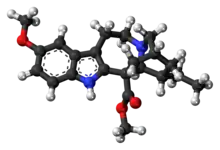Voacangine
Voacangine (12-methoxyibogamine-18-carboxylic acid methyl ester) is an alkaloid found predominantly in the root bark of the Voacanga africana tree, as well as in other plants such as Tabernanthe iboga, Tabernaemontana africana, Trachelospermum jasminoides, Tabernaemontana divaricata and Ervatamia yunnanensis.[2][3][4][5] It is an iboga alkaloid which commonly serves as a precursor for the semi-synthesis of ibogaine.[6] It has been demonstrated in animals to have similar anti-addictive properties to ibogaine itself.[7] It also potentiates the effects of barbiturates.[8] Under UV-A and UV-B light its crystals fluoresce blue-green, and it is soluble in ethanol.
 | |
 | |
| Names | |
|---|---|
| IUPAC name
12-Methoxyibogamine-18-carboxylic acid, methyl ester | |
| Systematic IUPAC name
Methyl 17-ethyl-7-methoxy-3,13-diazapentacyclo[13.3.1.02,10.04,9.013,18] nonadeca-2(10),4,6,8-tetraene-1-carboxylate[1] | |
| Other names
Methyl 12-methoxyibogamine-18-carboxylate | |
| Identifiers | |
3D model (JSmol) |
|
| ChEBI | |
| ChEMBL | |
| ChemSpider | |
| ECHA InfoCard | 100.214.137 |
| MeSH | Voacangine |
PubChem CID |
|
| UNII | |
CompTox Dashboard (EPA) |
|
| |
| |
| Properties | |
| C22H28N2O3 | |
| Molar mass | 368.477 g·mol−1 |
| Melting point | 136 to 137 °C (277 to 279 °F; 409 to 410 K) |
| log P | 3.748 |
Except where otherwise noted, data are given for materials in their standard state (at 25 °C [77 °F], 100 kPa).
Infobox references | |
Pharmacology
Pharmacodynamics
Voacangine exhibits AChE inhibitory activity.[9][10] Docking simulation reveals that it has inhibitory effect on VEGF2 kinase[11] and reduces angiogenesis.[12][13] Like ibogaine, its a potent HERG blocker in vitro.[14] It also acts as antagonist to TRPM8 and TRPV1 receptor, but agonist of TRPA1.[15][16]
Pharmacokinetics
The absolute bioavailability of voacangine is around 11-13%.[14]
Side effects
High doses of voacangine produce convulsions and asphyxia.[17]
Chemistry
Biosynthesis
The late-stage biosynthesis of (-)-voacangine in Tabernanthe iboga, a (-)-ibogamine-type alkaloid, has been elucidated via homology-guided transcriptome mining.[18] Suspected RNA transcripts involved in (-)-voacangine biosynthesis were identified via sequence homology to previously described enzymes comprising the (+)-catharanthine biosynthesis,[19] a (+)-ibogamine-type alkaloid from the taxonomically related plant Catharanthus roseus.
Ibogamine-type alkaloids are biosynthesized from the late stage intermediate stemmadenine acetate, a strictosidine-derived biosynthetic intermediate for a wide number of plant natural products. The biosynthesis of stemmadenine acetate has been characterized in C. roseus[19] but remains uncharacterized in T. iboga.

Conversion of stemmadenine acetate to (-)-voacangine in T. iboga involves five enzymes. First, stemmadenine acetate (1) is converted to precondylocarpine acetate (2) by one of three T. iboga precondylocarpine acetate synthases (TiPAS1/2/3), a flavin-dependent oxidase. Next, 2 is reduced to the enamine (3), dihydroprecondylocarpine acetate, by one of two NADPH-dependent T. iboga dihydroprecondylocarpine acetate synthase (TiDPAS1/2).
Up to this point, the biosynthetic path towards the (-)-ibogamine alkaloids and (+)-ibogamine alkaloids is identical. Stereochemical divergence occurs during the cyclization step, whereby T. iboga coronaridine synthase (TiCorS), a catharanthine synthase (CS) homologue, catalyzes a stereoselective formal Diels-Alder reaction on dehydrosecodine (4) to form coronaridine iminium (5). A proposed mechanism for dehydrosecodine formation from 3 involves iminium-formation/deacetylation, enamine-formation, and subsequent isomerization. Reduction of 5 to (-)-coronaridine (6) is proposed to be catalyzed by TiDPAS, although it is unclear if the reduction is actually enzymatic due to a lack of a reaction trial with only NADPH.[Note 1] After formation of 6, the substrate is then 10-hydroxylated by ibogamine 10-hydroxylase (I10H), a CYP450 enzyme, and subsequently 10-O-methylated by noribogaine-10-O-methyltransferase (N10OMT), a SAM dependent enzyme,[20] to form (-)-voacangine (7).
Notes
- See supplementary figure 15 of the Farrow et al. paper, citation 18. After initial incubation with TiCorS, no trial was ran with just NADPH.
References
- "Compound Report Card CHEMBL182120 - Voacangine". ChEMBL.
- Patel, M. B.; Miet, C.; Poisson, J. (1967). "Alkaloids of some African Tabernaemontana". Annales Pharmaceutiques Françaises. 25 (5): 379–384. PMID 5611538.
- Fatima, T.; Ijaz, S.; Crank, G.; Wasti, S. (1987). "Indole Alkaloids from Trachelospermum jasminoides". Planta Medica. 53 (1): 57–59. doi:10.1055/s-2006-962620. PMID 17268963. S2CID 910492.
- Liu, G.; Liu, X.; Feng, X. Z. (1988). "Ervayunine: A New Indole Alkaloid from Ervatamia yunnanensis". Planta Medica. 54 (6): 519–521. doi:10.1055/s-2006-962535. PMID 3212080. S2CID 84629414.
- Jenks, C. W. (2002). "Extraction Studies of Tabernanthe iboga and Voacanga africana". Natural Product Letters. 16 (1): 71–76. doi:10.1080/1057563029001/4881. PMID 11942686. S2CID 23390825.
- US patent 2813873, "Derivatives of the Ibogaine Alkaloids", issued 1957-11-19
- Tsing Hua (January 28, 2006). "Antiaddictive Indole Alkaloids in Ervatamia yunnanensis and their Bioactivity". Academic Journal of Second Military Medical University. Archived from the original on February 13, 2012. Retrieved August 9, 2008.
- http://medind.nic.in/iby/t08/i4/ibyt08i4p317.pdf
- VIEIRA I, MEDEIROS W, MONNERAT C, SOUZA J, MATHIAS L, BRAZ-FILHO R, PINTO A, SOUSA P, REZENDE C, EPIFANIO R (2008). "Two fast screening methods (GC-MS and TLC-ChEI assay) for rapid evaluation of potential anticholinesterasic indole alkaloids in complex mixtures" (PDF). Annals of the Brazilian Academy of Sciences. 80 (3): 419–426. doi:10.1590/s0001-37652008000300003. ISSN 0001-3765. PMID 18797794. Archived from the original (PDF) on 2020-02-19.
- Andrade MT, Lima JA, Pinto AC, Rezende CM, Carvalho MP, Epifanio RA (June 2005). "Indole alkaloids from Tabernaemontana australis (Muell. Arg) Miers that inhibit acetylcholinesterase enzyme". Bioorganic & Medicinal Chemistry. 13 (12): 4092–5. doi:10.1016/j.bmc.2005.03.045. PMID 15911323.
- Kim Y, Sugihara Y, Kim TY, Cho SM, Kim JY, Lee JY, Yoo JS, Song D, Han G, Rezeli M, Welinder C, Appelqvist R, Marko-Varga G, Kwon HJ (March 2020). "Identification and Validation of VEGFR2 Kinase as a Target of Voacangine by a Systematic Combination of DARTS and MSI". Biomolecules. 10 (4): 508. doi:10.3390/biom10040508. PMC 7226133. PMID 32230857.
- Kim Y, Jung HJ, Kwon HJ (January 2012). "A natural small molecule voacangine inhibits angiogenesis both in vitro and in vivo". Biochemical and Biophysical Research Communications. 417 (1): 330–4. doi:10.1016/j.bbrc.2011.11.109. PMID 22155252.
- "Antiaddictive Indole Alkaloids in Ervatamia yunnanensis and their Bioactivity". Academic Journal of Second Military Medical University. January 28, 2006.
- Mair CE, de Miranda Silva C, Grienke U, Kratz JM, Carreño F, Zimmermann ES, de Araújo BV, Dalla Costa T, Rollinger JM (July 2016). "Pharmacokinetics of hERG Channel Blocking Voacangine in Wistar Rats Applying a Validated LC-ESI-MS/MS Method". Planta Medica. 82 (11–12): 1030–8. doi:10.1055/s-0042-107800. PMID 27257769. S2CID 24504763.
- Terada Y, Horie S, Takayama H, Uchida K, Tominaga M, Watanabe T (February 2014). "Activation and inhibition of thermosensitive TRP channels by voacangine, an alkaloid present in Voacanga africana, an African tree". Journal of Natural Products. 77 (2): 285–97. doi:10.1021/np400885u. PMID 24484240.
- Lo MW, Matsumoto K, Iwai M, Tashima K, Kitajima M, Horie S, Takayama H (January 2011). "Inhibitory effect of Iboga-type indole alkaloids on capsaicin-induced contraction in isolated mouse rectum". Journal of Natural Medicines. 65 (1): 157–65. doi:10.1007/s11418-010-0478-6. PMID 21042867. S2CID 25706616.
- "Erowid Voacanga africana Vault : Info #1".
- Farrow, Scott C.; Kamileen, Mohamed O.; Caputi, Lorenzo; Bussey, Kate; Munday, Julia E. A.; McAtee, Rory C.; Stephenson, Corey R. J.; O'Connor, Sarah E. (31 July 2019). "Biosynthesis of an Anti-Addiction Agent from the Iboga Plant". Journal of the American Chemical Society. 141 (33): 12979–12983. doi:10.1021/jacs.9b05999. PMC 6706869. PMID 31364847.
- Qu, Yang; Easson, Micahel E. A. M.; Simionescu, Razvan; Hajicek, Josef; Thamm, Antje M. K.; Salim, Vonny; De Luca, Vicenzo (March 6, 2018). "Solution of the multistep pathway for assembly of corynanthean, strychnos, iboga, and aspidosperma monoterpenoid indole alkaloids from 19E-geissoschizine". Proceedings of the National Academy of Sciences. 115 (12): 3180–3185. Bibcode:2018PNAS..115.3180Q. doi:10.1073/pnas.1719979115. PMC 5866588. PMID 29511102.
- Farrow, Scott C.; Kamileen, Mohamed O.; Meades, Jessica; Ameyaw, Belinda; Xiao, Youli; O'Connor, Sarah E. (September 7, 2018). "Cytochrome P450 and O-methyltransferase catalyze the final steps in the biosynthesis of the anti-addictive alkaloid ibogaine from Tabernanthe iboga". J Biol Chem. 293 (36): 13821–13833. doi:10.1074/jbc.RA118.004060. PMC 6130943. PMID 30030374.